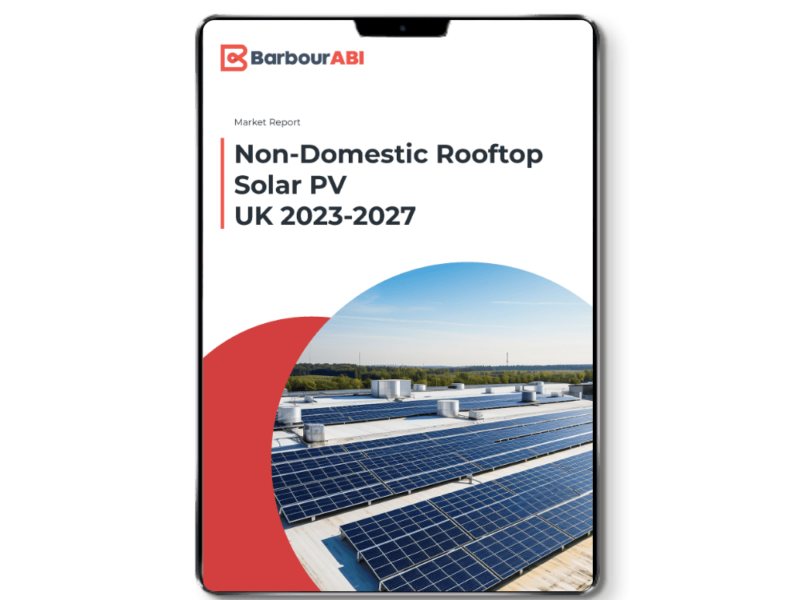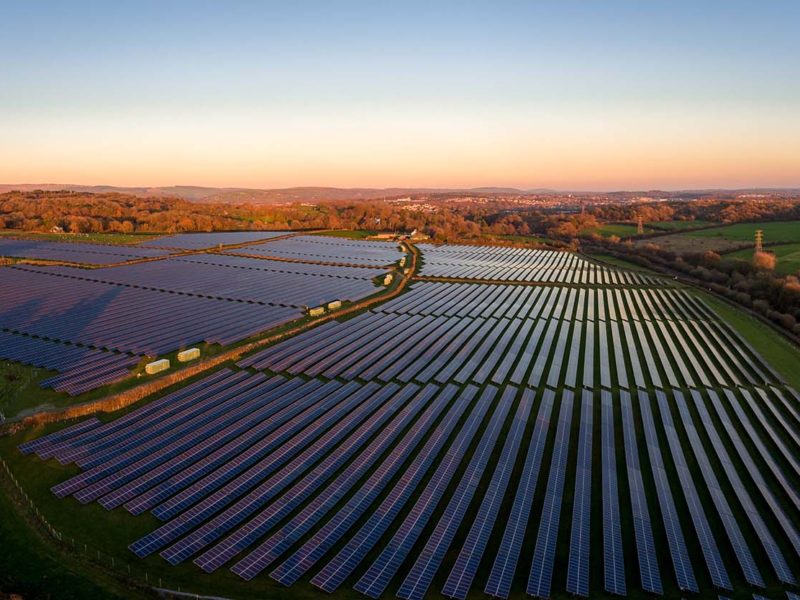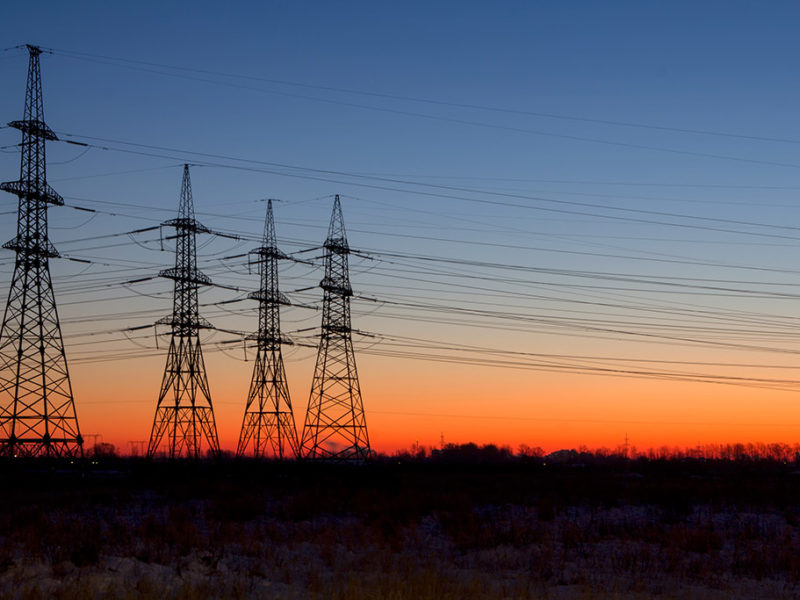Non-Domestic Rooftop Solar PV Market Report UK 2023-2027
Available as an Instant Download PDF
Our Non-Domestic Rooftop Solar PV Market Report is the second in our series on renewable energy.
Covering commercial & industrial properties as well as NHS, universities, schools and local authority leisure centres who offer big potential.
£1,499.00 Exc. VAT
This is the first edition of Barbour ABI’s report on non-domestic rooftop solar PV covering: warehousing, factories, retail, schools, higher education, leisure & hospitality etc. It provides an analysis of the annual and cumulative deployment of solar PV capacity across the rooftops of non-domestic buildings.
There is an estimate of the breakdown of the deployment of capacity by end-use sector and a forecast of which sectors have the greatest potential for future growth.
We also identify key stakeholders including commercial and industrial landlords and investors, retail groups and other major tenant organisations.
The PESTLE analysis offers a detailed review of key growth drivers and potential barriers to the rate of uptake.
Key Issues Covered in the Report
- Review of rooftop solar PV deployment during the subsidies era (i.e. Renewables Obligation and Feed-in-Tarrif). Barbour ABI quantitative and qualitative review of the roll-out of non-domestic rooftop solar in the post-subsidy era.
- Review of UK non-domestic building stock by floor area and, where possible, by roof area by end-use sub-sector
- Detailed overview of annual electricity consumption by main non-domestic sub-sectors; review of annual greenhouse gas emissions by main non-domestic sub-sectors.
- Review of key PESTLE factors including: grid connectivity; funding models, primarily PPAs (power purchase agreements; decline in prices of solar panels; government policies e.g. overarching UK climate change policy, changes to EPC regulations and Net Zero ambitions, public sector decarbonization scheme and mandatory ESG reporting; pan-global initiatives to tackle climate change including United Nations’ Race to Zero campaign, Science Based Targets and Climate Ambition Alliance; review of private sector initiatives e.g. Climate Action 100+, Net Zero Asset Managers; coverage of skills shortages facing the ‘green’ economy
- Barbour ABI’s own estimates of the market potential for the future deployment of non-domestic rooftop solar PV, identifying key types of buildings i.e. warehousing, factories, schools & universities and the NHS estate.
- Identification of key stakeholders: property owners /landlords, corporate occupiers and leading developers-installers of rooftop solar PV systems.
Some of the Companies Featured:
Absolute Solar and Wind, Advanced Renewable Power, Ameresco, Anesco, Aniron Renewables, Atrato Onsite Energy Plc, Beba Energy, Cactus Energy, Centreco UK, Centrica Business Solutions, Clean Earth Energy, Custom Solar Ltd, DORE, East Green Energy, Eco Partners, Ecolution Group, Eden Sustainable, EDF Renewables Solar, Electron Green, Empower Energy, Emtec Energy, Engenera Renewables Group, EvoEnergy, Exeo Energy, FES Support Services, Forster Energy, GEO Green Power, Gondola Pro, Joju Solar, Kingspan Energy, Mypower, Natural Generation, Noble Green Energy, Olympus Power, Ortus Energy, Perfect Sense Energy, Photon Energy, Push Investments, Revolution Energy Services, SAS Energy, Sol PV Group, Solarsense (UK), Spirit Solar, Sungift Solar, Syzygy Consulting, Vital Energi, Watt Energy Saver, Zestec Asset Management
Areas of Particular Interest
- Quantification of the annual and cumulative deployment (MWp) of non-domestic rooftop solar PV arrays to 2022.
- Breakdown and reviews of rooftop deployment solar PV deployment by types of buildings: -warehousing, factories, retail outlets, hospitality & leisure buildings, schools, universities, public administration (e.g. public sector offices, fire stations, police stations, MoD buildings etc).
- Table showing largest non-domestic rooftop arrays in UK by specific building types, of 3MWp and higher.
- Major stakeholder reviews:- summaries of Net Zero and interim carbon reduction targets; data on rooftop solar PV capacity where possible and relevant. Key companies reviewed include: largest industrial landlords /REITs (real estate investment trusts) e.g. Prologis, Tritax, Logicor and SEGRO etc; the supermarket groups and other major retailers operating out-of-town; major out-of-town retail landlords e.g. British Land, M & G Real Estate, New River REIT, Landsec etc;
- Table summarizing 40+ key developers, installers and O & M firms active in the non-domestic rooftop solar PV market e.g. Custom Solar, Zestec, Photon Energy, Push.
- Estimates of potential rooftop solar PV capacities in key sectors i.e. warehousing, factories, schools and out-of-town retail sites.
KEY AREAS COVERED IN THE REPORT
Market review to 2022
- Review of electricity generation and consumption 2012-2022
- Overview of UK territorial greenhouse gas (GHG) emissions 2000-2022
- Review of overall renewable electricity generation 2012-2022
- Review of electricity consumption and GHG emissions in the commercial, industrial and public non-housing sectors.
- Identification and overview of largest sources of GHG emissions from non-domestic buildings e.g. iron & steel processing plants, cement works.
- Review of non-domestic rooftop solar PV market:- overview of UK total cumulative solar PV deployment to 2022; annual deployment of non-domestic rooftop solar PV capacity to 2022; cumulative non-domestic rooftop solar PV deployment to 2022; review of deployment of non-domestic rooftop solar PV during the subsidy era.
Market influences and drivers
- PESTLE analysis –
- Political – 2050 carbon Net Zero target; National Infrastructure Strategy; Revisions to energy National Policy Statements for infrastructure; Climate Ambition Alliance, Race to
- Net Zero and SBTi; business /corporate initiatives.
- Economic – growth in PPAs; green skills shortages; increases in energy costs; declining costs of PV panels and installation; solar panel supply issues; Smart Export Guarantee
- Social – local campaigns against solar farms and widespread support for rooftop solar PV
- Technological – improvements in solar cell conversion efficiency; R & D into alternative cell materials; barriers to grid connection
- Legal- Planning requirements and Building Regulations, Companies Act and ESG reporting; changes to EPC regulations
- Environmental – irradiance levels across UK
End use sector review
- Review of England & Wales non-domestic building stock (numbers and GIFA) by sub-sector e.g. factories, warehouses, school buildings, stand-alone retail stores etc.
- Summary of electricity consumption by end-user types
- Overview of non-domestic rooftop solar PV deployment by estimated capacities by end-use sub-sector.
- Summary review of largest installations in UK
- End user sub-sector review of rooftop solar PV deployment; number of buildings, total floor area; electricity consumption by business type; estimates of size of rooftop solar PV capacity by end-user sub-sector.
Stakeholder review
- Focus of Section is on the key areas offering substantial potential for hosting solar PV where there is a high level of market concentration among leading players with large property portfolios i.e. leading manufacturing groups, are housing landlords, retail groups and major landlords.
- Overview of manufacturing industry by business type: turnovers, employment levels and market concentration; estimated potential rooftop solar PV capacity among UK factories.
- Overview of industrial /logistics landlords sub-sector: total GIFA/roof area and total number of assets in portfolios; estimate of potential capacity for hosting rooftop solar PV; summaries of Net Zero policies, current and targeted rooftop solar PV installations where known.
- Overview of retail sectors with focus on out-of-town supermarkets, other major retail groups and leading retail landlords:- GIFA/roof area and total number of out-of-town stores in portfolios; estimate of potential capacity for hosting rooftop solar PV; summaries of Net Zero policies, current and targeted rooftop solar PV installations where known.
- Other major users of rooftop solar including Associated British Ports, Amazon GB and Premier Inn.
Forecast
- Review of general prospects regarding the future deployment of rooftop solar PV.
- Sector focus on those offering the greatest potential for the large-scale deployment of rooftop solar PV:
- Key focus on factories, warehousing, education buildings, NHS estate and the out-of-town retail sector.
On 27 February 2022, the Intergovernmental Panel on Climate Change finalised the second part of the Sixth Assessment Report, Climate Change 2022: Impacts, Adaptation and Vulnerability, the Working Group II contribution to the Sixth Assessment Report.
In summary, it states the world has reached a point when humans and nature are being pushed beyond their abilities to adapt and that over 40% of the world’s population are ‘highly vulnerable’ to extreme weather events linked to climate change like floods and heatwaves.
Following COP26 and the UK’s government’s commitment to zero CO2 emissions by 2050 there is now a sense of urgency that fossil fuel dependent countries must cut their use right back while also investing much more heavily in renewable energy, with a major focus on wind and solar power.
In line with the government’s Sixth Carbon Budget, by 2035 greenhouse gas emissions need to be reduced by 78%. Between them, the CCC states wind and solar power will need to provide 75-90% of the UK’s electricity in 2035, with solar power alone delivering 60TWh a year.
Published in late 2021, the report Lighting the Way from Solar Energy UK says it is ‘catalysing our members to pave the way for 40GWp of solar energy capacity by 2030’. This means around 25GWp will need to be delivered over a 9-year period, equating to 2.7GWp a year.
Contents
1. Introduction
1.2 Context
1.2 Definition
1.3 Frequently used abbreviations in the report
1.4 Methodology
2. Market Summary
2.1 Summary of electricity generation and consumption
2.2 Overview of energy consumption and territorial GHG emissions in the commercial, industrial and public administration sectors
2.3 Rooftop solar PV market
3. Market Influences and Drivers
3.1 Main market influences and drivers
3.2 Political
3.2.1 Overarching UK climate change policy
3.2.2 The Climate Ambition Alliance, Race to Zero campaign and SBTi
3.2.3 Business / corporate initiatives
3.3 Economic influences and drivers
3.3.1 Increases in energy costs
3.3.2 Declining costs of solar PV systems
3.3.3 Rooftop solar PV power purchase agreements (PPAs)
3.3.4 Smart Export Guarantee (SEG)
3.3.5 Public sector decarbonisation scheme (PSDS)
3.3.6 Demand – supply balance re solar panels
3.3.7 Shortage of skills in the ‘green’ economy
3.4 Social influences and drivers
3.5 Technology factors
3.5.1 Connectivity to the grid and DNO networks
3.5.2 Improvements in conversion efficiency of c-Si solar cells and larger module formats
3.5.3 Other commercially available cell materials and R & D into new alternatives
3.6 Legal influences and drivers
3.6.1 Planning requirements
3.6.2 Building regulations
3.6.3 The Companies Act and ESG reporting.
3.6.4 Changes to EPC regulations
3.7 Environmental factors
3.7.1 Irradiance levels
4. end use sector deployment of rooftop solar pv
4.1 Overview
4.1.1. Commercial & industrial and public administration building stock
4.1.2 Electricity consumption
4.1.3 Review of rooftop solar PV deployment
4.2. Industrial – Manufacturing
4.2.1 Building stock
4.2.2 Electricity consumption
4.2.3 Review of rooftop solar PV deployment
4.3 Commercial – Retail
4.3.1 Building stock
4.3.2 Electricity use
4.3.3 Rooftop solar PV deployment
4.4 Commercial – Offices
4.4.1 Building stock
4.4.2 Electricity usage
4.4.3 Rooftop solar PV deployment
4.5 Commercial – Hospitality & leisure
4.5.1 Building stock
4.5.2 Electricity use
4.5.3 Rooftop solar deployment
4.6 Commercial – Warehouses and stores
4.6.1 Building stock
4.6.2 Electricity use
4.6.3 Review of rooftop solar PV deployment
4.7 Public administration – Education
4.7.1 Building stock
4.7.2 Electricity usage
4.7.3 Rooftop solar deployment
4.8 Public administration – Healthcare
4.8.1 Building stock
4.8.2 Electricity usage
4.8.3 Rooftop solar PV deployment
4.9. Public administration – Government buildings
4.9.1 Building stock
4.9.2 Electricity usage
4.9.3 Deployment of rooftop solar PV
5. KEY stakeholder groups
5.1 Overview
5.2 Manufacturers
5.3 Logistics landlords – distribution centres and other warehousing
5.4 Retail
5.4.1 Supermarket groups
5.4.2 Retail parks and shopping centre landlords and largest tenants
5.5 Others
5.5.1 Solar PV developers and installers
6. market forecasts
6.1 Overview
6.2 C & I rooftop solar PV prospects
6.2.1 General prospects
6.2.2 Factories
6.2.3 Warehousing
6.2.4 Education buildings
6.2.5 NHS
6.2.6 Retail
APPENDICES
TABLES & CHARTS
CHART 1: UK ELECTRICITY GENERATION (TWH) 2012-202210
CHART 2: UK TERRITORIAL GHG EMISSIONS (MTCO2E) BY MAIN SOURCE CATEGORY 2012-2022P 11
CHART 3: UK RENEWABLES ELECTRICITY GENERATION (TWH) 2012-2022 12
CHART 4: UK ELECTRICITY CONSUMPTION (TWH) IN THE COMMERCIAL, INDUSTRIAL AND PUBLIC ADMINISTRATION SECTORS 2012-2022 13
CHART 5: UK OTHER – TERRITORIAL GHG (MTCO2E) BY SOURCE CATEGORY: – BUSINESS, INDUSTRIAL PROCESSES, PUBLIC ADMINISTRATION AND
AGRICULTURE 2012-2022P14
TABLE 6: UK TERRITORIAL GREENHOUSE GAS EMISSIONS (MTCO2E) FROM NON-DOMESTIC BUILDINGS BY MAIN END USE 2020, 2010, 2000
14
CHART 7: CUMULATIVE TOTAL SOLAR PV CAPACITY (GWP) TO DECEMBER 2022 15
TABLE 8: UK ANNUAL DEPLOYMENT OF NON-DOMESTIC ROOFTOP PV CAPACITY (MWP) 2010-2022 17
CHART 9: CUMULATIVE NON-DOMESTIC ROOFTOP SOLAR PV CAPACITY (GWP) TO DECEMBER 2022 17
CHART 10: UK TOTAL DEPLOYMENT OF COMMERCIAL & INDUSTRIAL ROOFTOP SOLAR PV INSTALLATIONS BY DECLARED NET CAPACITY (MWP)
UNDER THE FEED IN TARIFF AND RENEWABLES OBLIGATION 2010-2020 18
CHART 11: UK TOTAL DEPLOYMENT OF INDUSTRIAL AND COMMERCIAL ROOFTOP SOLAR PV INSTALLATIONS BY DECLARED NET CAPACITY (MWP)
UNDER THE FEED IN TARIFF 2010-2020 TOTAL 19
TABLE 12: UK X MARKET PESTLE SUMMARY 202320
TABLE 13: SCIENCE BASE TARGETS INITIATIVE (SBTI) – NUMBER OF UK COMPANIES WITH NEAR TERM AND NET ZERO TARGETS SET AND
COMMITTED BY SUB-SECTOR22
TABLE 14: SELECTION OF ROOFTOP SOLAR PV PPAS 28
CHART 15: MIX BETWEEN SOLAR FARMS PROPOSED UNDER THE RENEWABLES OBLIGATION AND FEED-IN-TARIFF, IN OPERATION, REFUSED AND
ABANDONED/WITHDRAWN 33
CHART 16: LONG-TERM AVERAGE PHOTOVOLTAIC POWER POTENTIAL (PVOUT) ACROSS THE UK 1994-2018 44
TABLE 17: ENGLAND & WALES: NON-DOMESTIC BUILDINGS (NUMBERS AND GIFA) – CATEGORISED ACCORDING TO VOA ‘NDR STOCK OF
PROPERTIES 2022’45
TABLE 18: UK NON-DOMESTIC BUILDINGS GAS AND ELECTRICITY USAGE 2021 46
CHART 19: UK NON-DOMESTIC ROOFTOP SOLAR PV CAPACITY SHARE BY FINAL END USER SECTORS 2012-2022 47
CHART 20: UK LARGEST NON-DOMESTIC ROOFTOP SOLAR PV SITE INSTALLATIONS OF 3MWP & OVER IN 2023 47
TABLE 21: UK MANUFACTURING INDUSTRY – FACTORY BUILDING NUMBERS AND FLOOR AREAS, END OF MARCH 202248
TABLE 22: UK ELECTRICITY CONSUMPTION IN THE MANUFACTURING INDUSTRY BY SUB-SECTOR 49
CHART 23: UK ELECTRICITY CONSUMPTION ACROSS THE MANUFACTURING AND PRODUCTION SECTOR BY APPLICATION 50
CHART 24: UK’S LARGEST INDUSTRIAL ROOFTOP SOLAR PV INSTALLATIONS OVER 2MWP AT Q1 202351
TABLE 25: ENGLAND & WALES NUMBERS OF RATEABLE LARGER STAND-ALONE RETAIL OUTLETS BY TYPE, 2022 53
CHART 26: RETAIL SECTOR – % MIX OF ELECTRICITY CONSUMPTION BY TYPE OF RETAIL OUTLET 54
TABLE 27: ENGLAND & WALES – NUMBERS OF HOSPITALITY & LEISURE FACILITIES BY TYPE 56
CHART 28: LEISURE & HOSPITALITY: ELECTRICITY CONSUMPTION (TWH AND %) BY MAIN SUB-SECTOR 57
TABLE 29: ENGLAND & WALES – NUMBER OF WAREHOUSING & STORAGE BUILDINGS BY TYPE, 2022 58
TABLE 30: UK WAREHOUSING – BUILDING NUMBERS AND FLOOR AREAS, 2022 58
CHART 31: UK WAREHOUSES & STORES-ELECTRICITY CONSUMPTION (TWH AND %) BY PROPERTY TYPE59
CHART 32: UK’S LARGEST WAREHOUSE ROOFTOP SOLAR PV SITE INSTALLATIONS OF 2MWP + IN 2023 60
TABLE 33: UK SCHOOLS – SELECTED SUMMARY ESTATES STATISTICS 2022 61
TABLE 34: HIGHER EDUCATION ESTATES SELECTED SUMMARY DATA 202162
TABLE 35: GB COLLEGES OF FURTHER EDUCATION ESTATES SELECTED SUMMARY STATISTICS 62
CHART 36: EDUCATION – % ELECTRICITY CONSUMPTION BY TYPE OF INSTITUTION63
TABLE 37: UK HEIS – BIGGEST USERS OF RENEWABLE ENERGY, 2022 63
TABLE 38: UK NUMBERS OF HEALTHCARE BUILDINGS/FACILITIES AND GIFA 2022 64
6
CHART 39: NHS ENGLAND AND WALES – % ELECTRICITY CONSUMPTION BY INSTITUTION 65
TABLE 40: ENGLAND & WALES – NUMBERS OF GOVERNMENT BUILDING BY TYPE66
CHART 41: OTHER PUBLIC SECTOR ADMINISTRATION – % ELECTRICITY CONSUMPTION (TWH AND %) BY SUB-SECTOR 67
TABLE 42: UK MANUFACTURING INDUSTRY – NUMBERS OF BUSINESSES AND TURNOVERS BY MAIN SUB-SECTORS 2022 68
TABLE 43: UK ENERGY CONSUMPTION AND POINT SOURCE EMISSIONS BY MAIN MANUFACTURING /PROCESSING SECTORS 2020 69
TABLE 44: LEADING LOGISTICS AND DISTRIBUTION WAREHOUSING LANDLORDS IN THE UK 70
TABLE 45: UK LEADING GROCERY MULTIPLES -NUMBER OF STAND-ALONE SUPERMARKETS, RDCS AND ESTIMATED ROOFTOP PV CAPACITY 72
TABLE 46: LEADING RETAIL PARK OWNERS / LANDLORDS – NUMBER OF SITES AND AGGREGATE FLOORSPACE 74
TABLE 47: LARGEST OUT-OF-TOWN NON-GROCERY WAREHOUSE STORE GROUPS, NUMBER OF STORES AND FLOORSPACE 77
TABLE 48: LEADING DEVELOPERS, INSTALLERS AND O & M PROVIDERS IN THE UK NON-DOMESTIC ROOFTOP SOLAR PV MARKET 80
TABLE 49: ESTIMATES OF NON-DOMESTIC ROOFTOP SOLAR PV CAPACITY Q2 2023 AND POTENTIAL CAPACITY BY MAIN SECTORS 84

Paired Report Discount
Save £250 for every two reports you buy
Discount applied in basket
Frequently bought together

Trusted by industry leaders
For more detailed requests speak to our research experts directly
By using this form you agree that your data will be processed and protected in line with our Privacy Policy.
Research you can depend on
Our reports go deeper to give you the insights needed to make your next strategic move.
- Detailed assessment of the market – analysis of the market structure and recent developments within the market.
- Market prospects up to 4 years – market value, opportunities, impact of Covid-19, Brexit etc.
- Detailed information – market size, influences, market factors and key players.
- Analysis by product group – market size, product mix, sector trends etc.





